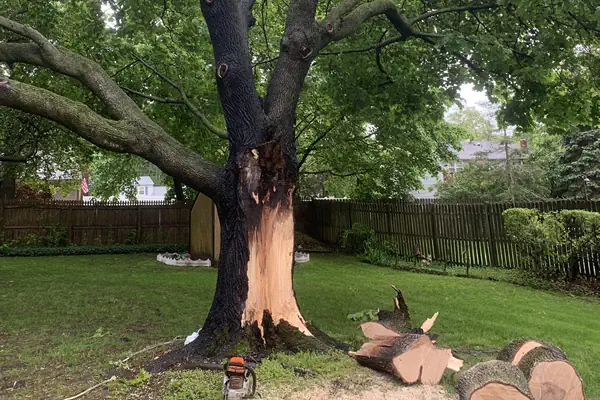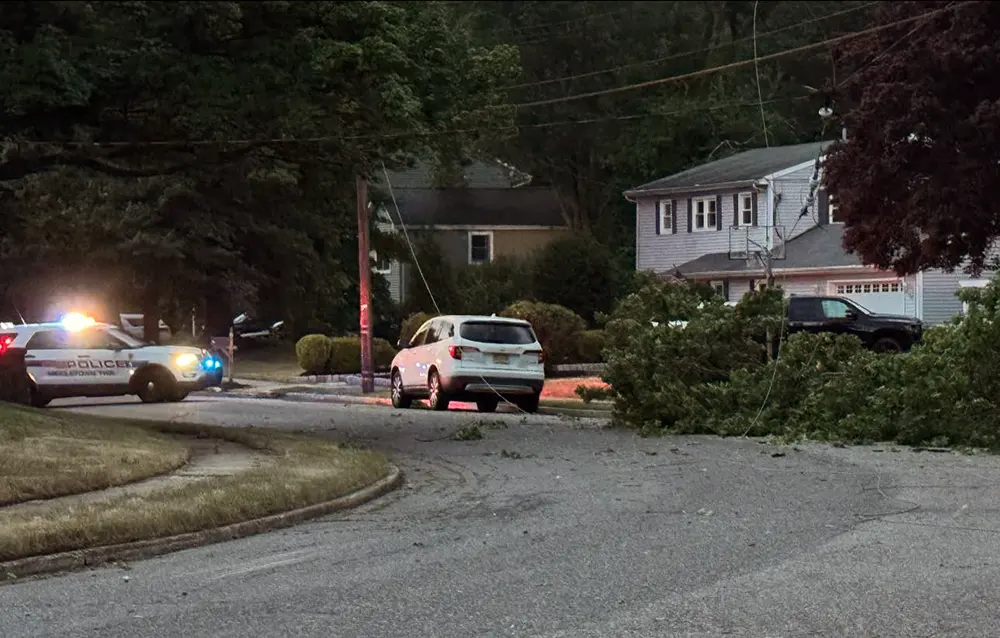June 24, 2024: This past weekend, Middletown faced severe storms that caused significant disruptions throughout the area. Amid a relentless heatwave, the fast-moving storm brought power outages, water main breaks, and damage that is being investigated as a possible tornado. The aftermath has left the community dealing with scattered tree debris and flooded streets.
Middletown Public Works teams have been working tirelessly to clear debris and ensure the safety of residents. Their round-the-clock efforts are helping to keep the streets safe and accessible.
On Friday afternoon, the storm knocked out electricity for more than 1,500 Jersey Central Power & Light (JCP&L) customers in Middletown. As of Monday afternoon, approximately 6,100 customers in Monmouth County are still without power. JCP&L is providing free water and ice at the following locations in Middletown to assist affected residents:
- Acme: 616 Newman Springs Rd., Lincroft
- Food Circus: 426 Route 36 and Wilson Ave., Port Monmouth
- Shop Rite: 1500 Route 35, Middletown
The recent weather has also posed risks to trees, potentially weakening their structure and making them hazardous. It is advisable for residents to schedule a tree risk evaluation once the situation normalizes to prevent further damage and ensure safety.
Damage From The Past Weekend's Storm
Here, we see a tall tree next to a house in Middletown, NJ, with a large limb hanging precariously. The limb is a clear example of how severe winds and heavy rain from recent storms have compromised the structural integrity of many trees in our area. Such damage not only threatens the safety of nearby structures but also poses significant risks to the residents. Addressing these hazards promptly is crucial to prevent potential accidents and ensure the well-being of our community.
Hufnagel Tree Service was called to safely remove this dangerous limb. This situation underscores the importance of regular tree evaluations, especially after major storms. Trees that have suffered damage can often harbor hidden weaknesses, making them susceptible to further harm in future weather events. As a certified arborist and concerned Middletown resident, Michael Hufnagel emphasizes the need for professional assessments to identify and mitigate these risks. By addressing tree damage proactively, we can protect our homes and families from the unpredictable impacts of severe weather.
Recent Events May Damage Trees, Setting Up A Future Disaster

Powerful storms and tornadoes can have a significant impact on trees, causing both immediate and long-term damage. The intense winds and heavy rains associated with these weather events can weaken trees by breaking branches, stripping leaves, and even cracking trunks. When trees lose branches and foliage, their structural integrity is compromised, making them more susceptible to future damage. Tornadoes, with their violent rotational winds, can twist and snap trunks, leaving trees with internal stresses and fractures that are not always immediately visible. This initial damage sets the stage for future storms to exploit these weaknesses, as compromised branches and trunks are less able to withstand subsequent weather events.
Existing damage in trees, such as those caused by previous storms, pests, or diseases, can be further exacerbated by powerful storms and tornadoes. For instance, trees with root rot or fungal infections may have compromised root systems, making them more prone to uprooting during high winds. Similarly, trees with old storm damage, such as cracked limbs or weakened trunks, can experience catastrophic failure under the pressure of a new storm. The saturated soil from heavy rains can also reduce the stability of the root systems, increasing the likelihood of trees toppling over. Over time, these cumulative damages can lead to trees becoming hazards, posing significant risks to nearby structures and people. Regular tree evaluations and maintenance are crucial to identify and mitigate these risks, ensuring the safety and health of trees in storm-prone areas.

